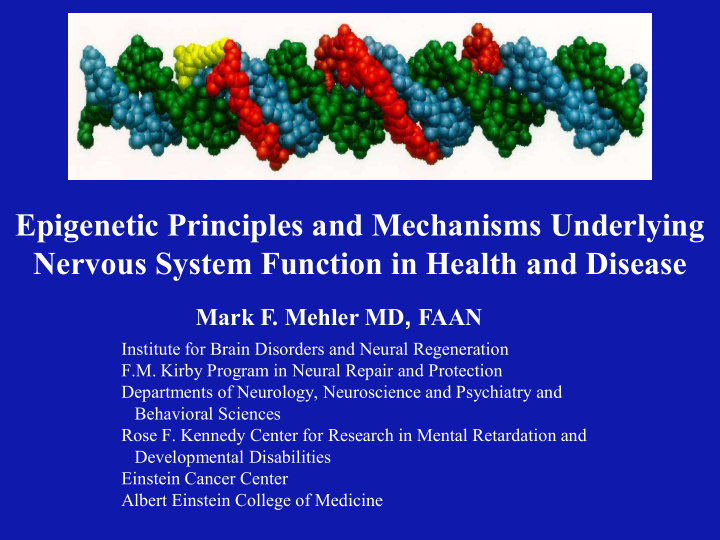



Epigenetic Principles and Mechanisms Underlying Nervous System Function in Health and Disease Mark F. Mehler MD , FAAN Institute for Brain Disorders and Neural Regeneration F.M. Kirby Program in Neural Repair and Protection Departments of Neurology, Neuroscience and Psychiatry and Behavioral Sciences Rose F. Kennedy Center for Research in Mental Retardation and Developmental Disabilities Einstein Cancer Center Albert Einstein College of Medicine
Unresolved Issues in Neuroscience Evolution of human brain form and function Limitations of bioenergetic reserve Basis of gene-environmental interactions Complexity of cellular identities and connectivity Plasticity/heritability of cognitive/behavioral traits Molecular genetics of neurological diseases
Cell Mol Life Sci 64:1531, 2007
The classical definition of epigenetics refers to modifications of gene expression and function not requiring primary changes in nucleotide sequence – DNA methylation – Histone code modifications – Nucleosome positioning – Higher-order chromatin remodeling
Organizational Structure of the Classical Epigenome I Higher-order chromatin remodeling Nucleosome positioning Post-translational histone tail modifications DNA methylation and methyl binding proteins JAMA 299:1346, 2008
Epigenetic Regulatory Factors in Neurodevelopmental Diseases: Enzymes that directly modulate chromatin structure Van Bokhoven and Kramer Neurobiol. Dis. (2010)
Epigenetic Regulatory Factors in Neurodevelopmental Diseases: Enzymes that indirectly modulate chromatin structure Van Bokhoven and Kramer Neurobiol. Dis. (2010)
Novel Epigenetic Mechanisms Non-Protein-Coding RNAs RNA Editing
Explosive Growth of Non-Coding RNAs During Eukaryotic Evolution J Exp Biol 210:1526, 2007
Subclasses of Non-Coding RNAs (ncRNAs) • Signal recognition particle (SRP) RNAs • Ribosomal RNAs (rRNAs) • Transfer RNAs (tRNAs) • Transcription initiation RNAs (tiRNAs) • Small nucleolar (spliceosomal) RNAs (snRNAs) • Small nucleolar RNAs (snoRNAs) • Sno-derived silencing RNAs (sniRNAs) • Telomerase RNA • MicroRNAs (miRNAs) • Small-interfering (cis-acting) RNAs (siRNAs) • Trans-acting antisense RNAs • Tiny non-coding RNAs (tncRNAs) • Small modulatory double-stranded (dsRNAs) RNAs (smRNAs) • Messenger RNA-like ncRNAs • Cytoplasmic ncRNAs • Heterogeneous nuclear RNAs (hnRNAs) • Genomic imprinting-related RNAs • X-chromosome inactivation-related RNAs (roX RNAs) • tRNA maturation-related RNAs (RNase P RNAs) • MacroRNAs/long-expressed ncRNAs (ENORs) Mehler & Mattick J. Physiol. 575:333, 2006
Non-Coding RNA Expression in Mammalian Brain PNAS 105:716, 2008
Non-Coding RNAs Associated with Neurological Genes PNAS 105:716, 2008 PNAS 105:716, 2008
RNA Editing Enzymes Recode Specific Base Pairs in Non-Coding and Coding RNAs to Fine-Tune Gene Expression and Function in Response to a Complex Environment RNA Biol 3:1, 2006
RNA Binding Proteins Regulate RNA Cellular Localization and Function Nat Rev Genet 8:533, 2007
The Role of RNA Binding Proteins in the Pathogenesis of Complex Diseases Nat Rev Genet 8:533, 2007
Short and Long Range Extracellular Trafficking of RNAs J Mol Endocrinol 40:151, 2007 Diverse RNA species may participate in signaling between adjacent neurons and across distributed neural networks RNAs may be transported to other organ systems through the systemic circulation RNAs may play a role in intergenerational inheritance through germline transmission
Expression of Receptors for Intercellular Transport of RNAs in Adult Brain J Mol Endocrinol 40:151, 2007
The New RNA Biology Science 319:1787, 2008
Towards Understanding and Treating Complex Neurological Diseases
Metabolic/homeostatic/environmental cues Essential cellular functions Genome regulation • genomic imprinting • cell cycle regulation • DNA replication/repair/recombination • gene dosage effect • long-range gene modulation • nuclear reorganization • telomere maintenance • genomic stability • gene transcription • epigenetic reprogramming • post-translational processing -DNA/RNA/protein • multigenerational heritability Adult brain functions Neural development • neuronal homeostasis/plasticity • neural induction • neural network connectivity • regional neural patterning • trans-neuronal signaling • stem cell self-renewal/maturation • adult neurogenesis • neuronal/glial subtype specification • neural regeneration • terminal differentiation • memory formation • synaptogenesis • higher-order cognitive processing Ann Neurol. 64:602, 2008
Expansion Repeat Disorders Nature 447, 932-940(21 June 2007)
Ann Neurol. 64:602, 2008
Ann Neurol. 64:602, 2008
Ann Neurol. 64:602, 2008
Ann Neurol. 64:602, 2008
Ann Neurol. 64:602, 2008
Pharmacoepigenomics J Cell Physiol 212:330, 2007
Recommend
More recommend